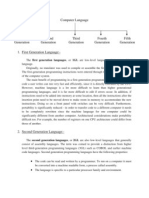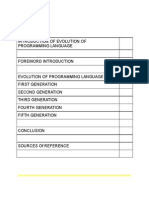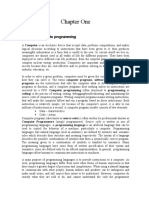0 ratings0% found this document useful (0 votes)
5 viewsCSC 315 Lecture 1
CSC 315 Lecture 1
Uploaded by
favouruturu03Copyright:
© All Rights Reserved
Available Formats
Download as PDF, TXT or read online from Scribd
CSC 315 Lecture 1
CSC 315 Lecture 1
Uploaded by
favouruturu030 ratings0% found this document useful (0 votes)
5 views3 pagesOriginal Title
CSC 315 LECTURE 1
Copyright
© © All Rights Reserved
Available Formats
PDF, TXT or read online from Scribd
Share this document
Did you find this document useful?
Is this content inappropriate?
Copyright:
© All Rights Reserved
Available Formats
Download as PDF, TXT or read online from Scribd
Download as pdf or txt
0 ratings0% found this document useful (0 votes)
5 views3 pagesCSC 315 Lecture 1
CSC 315 Lecture 1
Uploaded by
favouruturu03Copyright:
© All Rights Reserved
Available Formats
Download as PDF, TXT or read online from Scribd
Download as pdf or txt
You are on page 1of 3
CSC 315 - SURVEY OF PROGRAMMING LANGUAGES
OVERVIEW OF PROGRAMMING LANGUAGES
A computer program is a sequence of detailed instructions in a programming
language that a computer can execute or interpret. A computer program in its
human-readable form is called source code. Programming is the process of
designing and building an executable computer program to accomplish a specific
computing task or achieve a specific task, programming is how you get computers
to solve problems.
Programming is a science because it implements the algorithms described by
mathematics and science, it is a skill because it requires basic efforts. It is an
engineering because it requires trades offs between program size, speed, time
[required for development and debugging] and maintainability among many
solutions. It is an art, it requires creativity and employs imagination.
Levels/ Generations of Programming
a. First Generation Language [1GL]
Machine Language, 0’s and 1’s
b. Second Generation Language [2GL]
Assembly Language, mnemonics
c. Third Generation Language [3GL]
High level languages, procedure oriented or object oriented
d. Fourth Generation Programing Languages [4GL]
Very high level programming languages
e. Fifth generation language [5GL]
Natural languages
A. FIRST GENERATION PROGRAMMING LANGUAGES
This is the lowest level of programming language, it is the language used to
program the first generation computers. The instructions in the first generation
programming languages are made of binary numbers represented by 1s and 0s.
The 1s and 0s corresponds to the on and off states of electrical switches. It is easier
to understand by the machine but much difficult to interpret and learn by the
human programmer. Originally, no translator was used to compile or assemble the
first-generation language. The first-generation programming instructions were
entered through the front panel switches of the computer system. First generation
languages are very much adapted to a specific computer and CPU, and code
portability is therefore significantly reduced in comparison to higher level
languages. Modern day programmers still occasionally use machine level code,
especially when programming lower level functions of the system, such
as drivers, interfaces with firmware and hardware devices. Modern tools such as
native-code compilers are used to produce machine level from a higher-level
language
B. SECOND GENERATION PROGRAMMING LANGUAGE
The second generation programming language is also known as assembly
language, the programmer can write instructions faster but it is still not an easy
language to learn, An assembler is a program that translates assembly language
program into machine language. The symbolic representation of machine
Instructions, registers and memory addresses allows the programmer to produce
a human-readable program. For the computer to understand the program it must
be converted to a machine readable format using an Assembler. The Assembler
usually converts the Mnemonics via a one-to-one mapping from the mnemonic
representation to machine language, for a particular processor family and
environment. They are mostly used for the implementation of low-level kernels
and drivers and for performance-oriented and processing-intensive applications
such as computer games, graphic manipulation applications and video editing
applications. Assemblers allow for easier debugging of the program, and also
introduce more advanced programming mechanisms such as macro Programming
and structured Programming.
C. THIRD GENERATION PROGRAMMING LANGUAGE
The third generation programming language is also known as a high level
programming language, it is an English language it is a refinement of the second
generation programming language it allows users to write in familiar notation
rather than numbers or abbreviations, programmers in 3GLs are favored by using
aggregate data types, variable names and the ability to define sections of code as
subroutines. The program in 3GL is called the Source Program or Source Code and
it subsequently converted by a specialized program, the Compiler, to Object Code,
understandable by the specific computer and CPU, most high level languages are
not machine dependent, the translator for high level languages is either a compiler
or interpreter e.g of high level languages are FOTRAN COBOL, BASIC etc.
D. FOURTH GENERATION PROGRAMMING LANGUAGE
A fourth generation (programming) language (4GL) is a grouping of programming
languages that attempt to get closer than 3GLs to human language, form of
thinking and conceptualization. They are much more user oriented and allow
programmers develop programs with fewer commands compared to the third
generation programming language. Many 4GLs are associated with databases and
data processing, They consists of report generators query languages, application
generators and interactive database management system e.g RPG III [Report
Generator], SQL [Structured Query Language], NOMAD and FOCUS [DBMS] This
feature allows the efficient development of business-oriented systems with
languages that closely match the way domain experts formulate business rules and
processing sequences. Many of such data-oriented 4GLs are based on the
Structured Query Language (SQL), invented by IBM and subsequently adopted by
ANSI and ISO as the standard language for managing structured data.
E. FIFTH GENERATION LANGUAGE
This is a grouping of programming languages built on the premise that a problem
can be solved, and an application built to solve it, by providing constraints to the
program (constraint-based programming/ problem oriented), rather than
specifying algorithmically how the problem is to be solved (imperative
programming). In essence, this programming language is used to denote the
properties, or logic, of a solution, rather than how it is reached. Most constraint-
based and logic programming languages are fifth Generation programming
Languages. They are also known as natural language. Fifth generation
programming languages are designed to make the computer solve a given problem
without the programmer. Natural languages are part of the field of study known as
artificial intelligence, they develop machines to emulate human like qualities such
as learning, reasoning, communicating, seeing and hearing.
You might also like
- Introduction To Computer Programming1Document125 pagesIntroduction To Computer Programming1Nyabs YohanaNo ratings yet
- Not A CD 07Document34 pagesNot A CD 07Yumi SofriNo ratings yet
- Chapter1 1 PDFDocument18 pagesChapter1 1 PDFintensityNo ratings yet
- What Is Programming LanguageDocument4 pagesWhat Is Programming LanguageHarold Pasion100% (1)
- NOTESDocument4 pagesNOTEScossykin19No ratings yet
- Form 5 - CD 1Document34 pagesForm 5 - CD 1hakim abdullahNo ratings yet
- Chapter 1-Introduction To Computer ProgrammingDocument26 pagesChapter 1-Introduction To Computer Programmingbahru demeke100% (1)
- Introduction To ProgrammingDocument44 pagesIntroduction To ProgrammingarsyadNo ratings yet
- Types of Programming LanguageDocument6 pagesTypes of Programming LanguageOnline UserNo ratings yet
- Chapter TwoDocument8 pagesChapter Twon64157257No ratings yet
- Introduction To Programming: 1.1. What Is Computer Programming?Document73 pagesIntroduction To Programming: 1.1. What Is Computer Programming?Yaregal ChalachewNo ratings yet
- Generation of Computer LanguagesDocument5 pagesGeneration of Computer LanguagesSayani Chandra100% (4)
- Assignment # 3Document4 pagesAssignment # 3Shamsher KhanNo ratings yet
- Types of Programming Languages: 1. Low Level LanguageDocument14 pagesTypes of Programming Languages: 1. Low Level Languageshishay GebreNo ratings yet
- ICT Form 5 Chapter 1Document34 pagesICT Form 5 Chapter 1Benammi Al-KhawarizmiNo ratings yet
- 012.elementary Programming PrincipalsDocument45 pages012.elementary Programming PrincipalstheophilusorinaNo ratings yet
- Programming LanguagesDocument2 pagesProgramming LanguagesRamchand HansrajuaNo ratings yet
- 1. Computer Programming moduleDocument103 pages1. Computer Programming modulejacobdiribaNo ratings yet
- Chapter ElevenDocument86 pagesChapter ElevenHR SakibNo ratings yet
- ALPDocument119 pagesALPsdahmed5iNo ratings yet
- Dokumen - Tips - Program Language Generations and Programming Geofizoktatokvasssome Basic ConceptsDocument26 pagesDokumen - Tips - Program Language Generations and Programming Geofizoktatokvasssome Basic ConceptsNnosie Khumalo Lwandile SaezoNo ratings yet
- Chapter 1Document16 pagesChapter 1Oz GNo ratings yet
- Chapter 1 - Computer ProgrammingDocument12 pagesChapter 1 - Computer ProgrammingHabtie TesfahunNo ratings yet
- Generation of Computer LanguageDocument12 pagesGeneration of Computer LanguageFarrukh MehmoodNo ratings yet
- Programming Languages and Program Development ToolsDocument15 pagesProgramming Languages and Program Development ToolsOh ReviNo ratings yet
- LP - 7th Day - CLASS NOTESDocument14 pagesLP - 7th Day - CLASS NOTESMohammad Fahim AkhtarNo ratings yet
- CPE 101. Programming The ComputerDocument22 pagesCPE 101. Programming The Computerajayieridipupo2008No ratings yet
- BMS 201 C++ Notes 2021Document56 pagesBMS 201 C++ Notes 2021Brian MutuaNo ratings yet
- BMS 201 Handout 1 2021Document19 pagesBMS 201 Handout 1 2021Brian MutuaNo ratings yet
- Lesson - 5Document25 pagesLesson - 5dang2dangjindagi100% (1)
- Lecture 1 - Programming With VBDocument30 pagesLecture 1 - Programming With VBSimon Osabo Asamoah100% (2)
- Course Lecture NotesDocument149 pagesCourse Lecture NotesTolesa ShoreNo ratings yet
- Lecture 1 Introduction To ProgrammingDocument19 pagesLecture 1 Introduction To ProgrammingOm KNo ratings yet
- Module 1 JavaDocument46 pagesModule 1 JavaShibaZ KumarNo ratings yet
- It 101 - Lecture 1Document33 pagesIt 101 - Lecture 1Amoasi D' OxygenNo ratings yet
- Chapter 1 C++Document16 pagesChapter 1 C++Biniyam HagosNo ratings yet
- Chapter 1Document25 pagesChapter 1KhaiTeoNo ratings yet
- C Programming NotesDocument80 pagesC Programming NoteshasengaNo ratings yet
- Content:: Introduction of Evolution of Programming LanguageDocument15 pagesContent:: Introduction of Evolution of Programming Languageアザハリ ハズアンNo ratings yet
- Chapter 1 - Computer ProgrammingDocument9 pagesChapter 1 - Computer Programminghiwot kebedeNo ratings yet
- Form 5 Lesson Notes Part 1Document56 pagesForm 5 Lesson Notes Part 1Jack Low100% (1)
- C Program All Modules NewDocument120 pagesC Program All Modules NewDanayya swami SwamiNo ratings yet
- ComputerprogrammingDocument20 pagesComputerprogrammingSunil KumarNo ratings yet
- Chapter 5: PROGRAMMINGDocument57 pagesChapter 5: PROGRAMMINGquinnyqueen100% (13)
- Fundamental of Computer Programming - 1Document15 pagesFundamental of Computer Programming - 1dockanye3No ratings yet
- Chapter One: Department of Software Eng Fundamentals of Programming IDocument10 pagesChapter One: Department of Software Eng Fundamentals of Programming IGadaa AssebeNo ratings yet
- Elementary Programming PrinciplesDocument24 pagesElementary Programming Principlesismailmwas8186No ratings yet
- Generation of Programming LanguagesDocument6 pagesGeneration of Programming LanguagesNameer AL-omariNo ratings yet
- Chapter One: 1.1 Introduction To ProgrammingDocument10 pagesChapter One: 1.1 Introduction To Programmingnegash belihuNo ratings yet
- CS111-PART 4 - Brief Introduction To SoftwareDocument25 pagesCS111-PART 4 - Brief Introduction To SoftwareJian KusanagiNo ratings yet
- Program ImplementationDocument17 pagesProgram Implementationapi-29791090775% (4)
- DFC1023 - Problem Solving &program Design: Introduction To Programming LanguageDocument22 pagesDFC1023 - Problem Solving &program Design: Introduction To Programming LanguageSyahida ShaShaNo ratings yet
- Generations of Programming LanguagesDocument35 pagesGenerations of Programming LanguagessamNo ratings yet
- CSC 403 Lecture 1Document17 pagesCSC 403 Lecture 1koredekayode2023No ratings yet
- Lecture 5Document3 pagesLecture 5Aditi TanejaNo ratings yet
- Chapter 1 - Computer ProgrammingDocument11 pagesChapter 1 - Computer ProgrammingIbm FattyNo ratings yet
- Programming BasicsDocument40 pagesProgramming Basicsgeorgenathan010No ratings yet
- Chapter 3 - Computer Programming LanguagesDocument8 pagesChapter 3 - Computer Programming LanguagesFreddy MutuaNo ratings yet
- "Unleashing the Power of Assembly Language: Mastering the World's Most Efficient Code"From Everand"Unleashing the Power of Assembly Language: Mastering the World's Most Efficient Code"No ratings yet
- CHKDSK: "RAW Filesystem" Message: Support ForumDocument2 pagesCHKDSK: "RAW Filesystem" Message: Support ForumadauNo ratings yet
- Datasheet c5271Document1 pageDatasheet c5271Abel RodriguezNo ratings yet
- ECE486 Lab ManualDocument106 pagesECE486 Lab ManualDR ARINDAM SENNo ratings yet
- Lab 8 BiomechanicsDocument3 pagesLab 8 Biomechanicstalha.k.rajpootNo ratings yet
- WFH DocumentDocument18 pagesWFH DocumentBach TruongNo ratings yet
- Install Grafana 9 With Prometheus On RHEL 9 - CentOS Stream 9 - TechnixLeoDocument10 pagesInstall Grafana 9 With Prometheus On RHEL 9 - CentOS Stream 9 - TechnixLeoAymenNo ratings yet
- New SyspsDocument15 pagesNew SyspsRajKumarRockNo ratings yet
- Collection of Various BIOS UtilitiesDocument7 pagesCollection of Various BIOS Utilitiesxonikih593No ratings yet
- Netwrix Auditor v10.5 10-16-2022Document5 pagesNetwrix Auditor v10.5 10-16-2022Celestin TSHISHINo ratings yet
- Python Basics Cheat Sheet 1Document1 pagePython Basics Cheat Sheet 1srikanth patil100% (1)
- Owasp Zap Hostedscan Report 2024-02-12Document17 pagesOwasp Zap Hostedscan Report 2024-02-12faizan.rezaNo ratings yet
- Power AmplifierDocument17 pagesPower AmplifierAkinola AyomideNo ratings yet
- Introduction To VirtualizationDocument29 pagesIntroduction To VirtualizationProphx BliziceNo ratings yet
- App Design - PlanningDocument45 pagesApp Design - Planningtuanba86No ratings yet
- Sheet 2Document6 pagesSheet 2Toka AhmedNo ratings yet
- Shift RegistersDocument21 pagesShift RegistersKaustubh SreekharNo ratings yet
- CS201 Mcqs FinalTerm by Vu Topper RMDocument52 pagesCS201 Mcqs FinalTerm by Vu Topper RMPalwasha ShabbirNo ratings yet
- Allwinner F1C200s Datasheet V1 1Document21 pagesAllwinner F1C200s Datasheet V1 1李小华No ratings yet
- Computer StudyDocument45 pagesComputer StudyOlushola AdebisiNo ratings yet
- CPENT Module 09 Wireless Penetration TestingDocument49 pagesCPENT Module 09 Wireless Penetration TestingOleg PelschNo ratings yet
- AMS Documentation - Single-Account Landing Zone Onboarding GuideDocument144 pagesAMS Documentation - Single-Account Landing Zone Onboarding GuideAnkush AdlakhaNo ratings yet
- PHY547 - Lab Manual-Exp2 - SimulationDocument3 pagesPHY547 - Lab Manual-Exp2 - SimulationNurul Naafizah SulaimanNo ratings yet
- Features in Python: 1. Easy To CodeDocument4 pagesFeatures in Python: 1. Easy To Coderakesh kumarNo ratings yet
- Top SAP FIORI Interview Questions and AnswersDocument22 pagesTop SAP FIORI Interview Questions and Answersayshusubramani100% (1)
- CN Packet Tracer (Chetan)Document13 pagesCN Packet Tracer (Chetan)Chetan ChoudharyNo ratings yet
- Laboratory Exercise: CS201 Computer Programming 1 006 Trigonometry Page 1 of 7Document7 pagesLaboratory Exercise: CS201 Computer Programming 1 006 Trigonometry Page 1 of 7Diana Lync SapurasNo ratings yet
- Python OPC-UA DocumentationDocument721 pagesPython OPC-UA DocumentationdivergerNo ratings yet
- Microsoft OSDocument2 pagesMicrosoft OSJessica Sidra RaeNo ratings yet
- Assembly Language Test 1Document8 pagesAssembly Language Test 1Dennis MumanyiNo ratings yet
- 1817-SanDiegoCPMTDL Lau AdvancedpackagingDocument111 pages1817-SanDiegoCPMTDL Lau AdvancedpackagingPiyush ParasharNo ratings yet

























































































